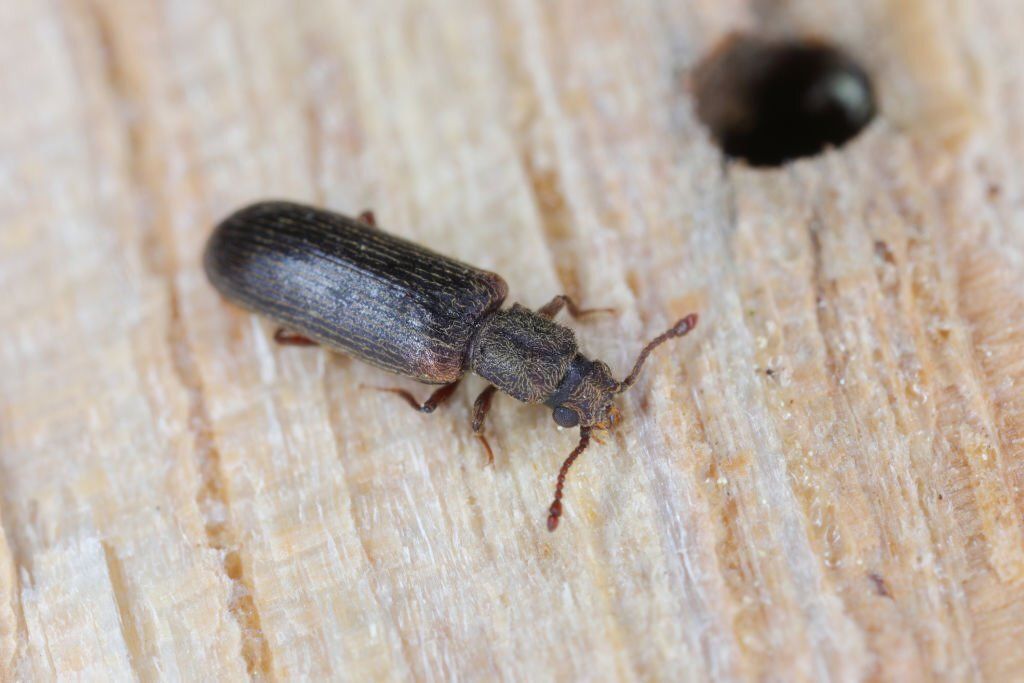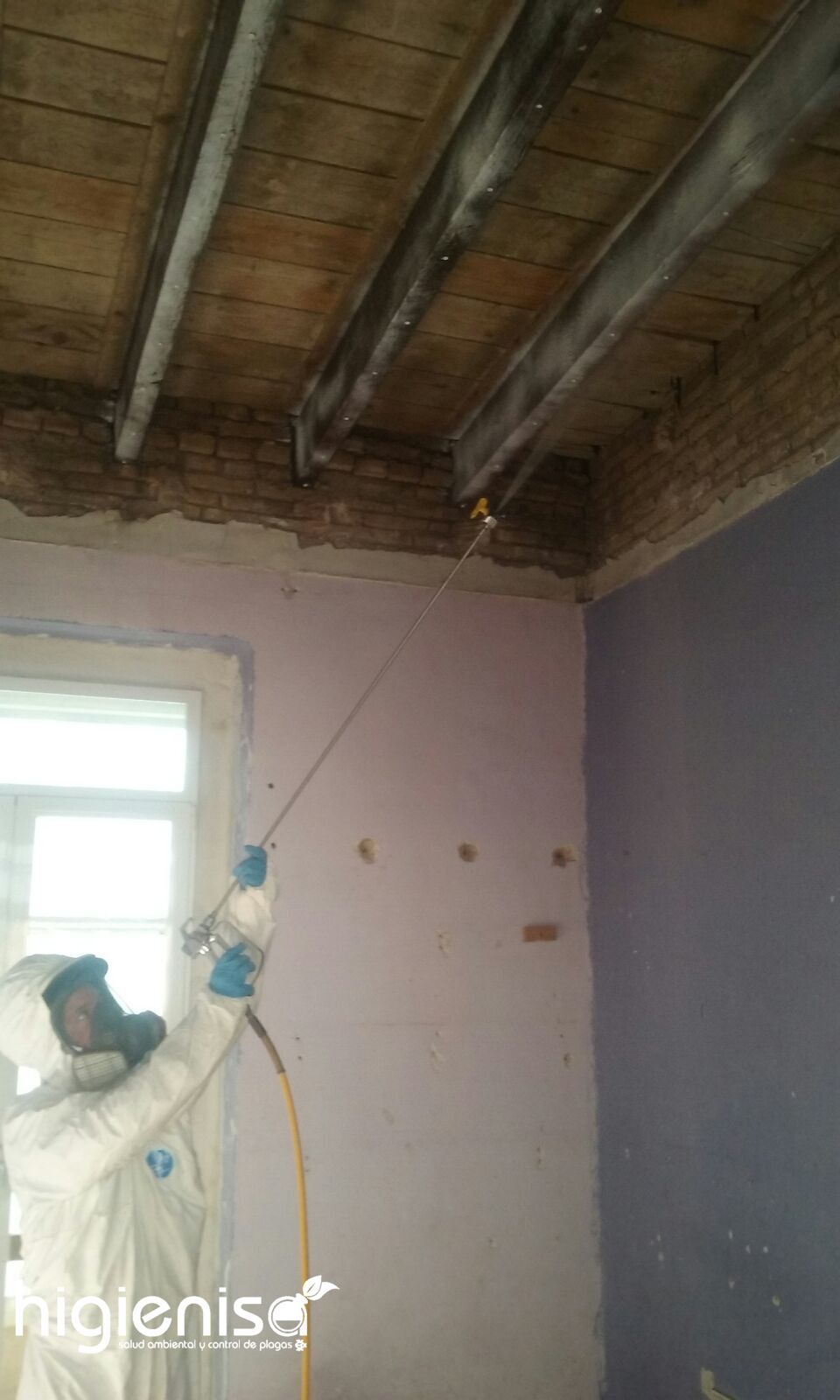Woodworms
Woodworms are xylophagous insects that feed on wood. These small insects have a life cycle that consists of four stages: egg, larva, pupa and adult. The larvae are responsible for damage to the wood, as they feed on it, drilling galleries and weakening its structure. As they grow, the larvae develop into adults and emerge from the wood, leaving characteristic holes. The presence of woodworms can cause significant damage to furniture, wooden structures and other objects. It is essential to identify and control woodworms effectively to avoid further problems.
eliminate woodworms - fumigate woodworms
Types of Woodworms in Spain: Complete Guide for their Identification and Control
Woodworm, one of the most feared visitors to any home or wooden structure, not only compromises the aesthetics of furniture and structures, but also their integrity and value. In Spain, various species of these xylophagous insects have established their presence, each with particular characteristics and specific control measures necessary to combat them effectively. In this article, we offer a complete guide that will not only facilitate the identification of the different types of woodworms present in the country, but will also provide effective strategies for their elimination and eradication.
We will explore from the most common ones, such as the common woodworm and the large woodworm. Additionally, we will discuss preventative techniques and professional treatment options.
Tipos de carcomas en España
common woodworm
Anobium Punctatum
This woodworm is one of the most common species in Spain. It is characterized by its small size, approximately between 2 and 5 millimeters in length. Their larvae feed on dry wood and usually infest furniture, door and window frames, as well as wooden structures in general. Signs of infestation include the presence of small exit holes, sawdust or fine dust in the vicinity of the affected wood.
Anobium Punctatum
- Family: AnobidaeLarva: white arched. From 5 to 7 mm.Adult: brown with striated elytra. From 2.5 to 5 mm.Duration of the life cycle: from 1 to 4 yearsGalleries: parallel to the grain and circular sectionSawdust: granularExit holes: circular from 1 to 2.5 mm.Attackable woods: sapwood of conifers and hardwoods. heartwood with rot
Lyctus brunneus
- Family: LyctidaeLarva: white arched. From 5 to 7 mm.Adult: brown with irregularly distributed pubescence. From 2.5 to 7 mm.Duration of the life cycle: from 6 to 12 monthsGalleries: parallel to the grain and circular in sectionSawdust: very fine and similar in touch to talcum powderExit holes: circular of 1 to 2 mm.Attackable woods : non-duraminized hardwood wood, with a certain starch content.
woodworm moth
Lyctus brunneus
Esta es otra especie de carcoma que se encuentra en España. A diferencia de otras carcomas, esta especie no necesita madera seca para infestar, ya que prefiere madera verde o recién cortada. Sus larvas se alimentan de los almidones presentes en la madera y pueden dañar seriamente las estructuras de madera en construcción o recién instaladas. Los agujeros de salida son más grandes y ovalados en comparación con otras carcomas.
large woodworm
Hylotrupes bajulus
The large woodworm is a larger species compared to other woodworms, reaching up to 25 millimeters in length. Their larvae are large and feed on soft wood, such as old furniture or aged wooden structures. This species can cause significant damage if not detected and controlled in time. The exit holes are usually "D" shaped and larger than those of other woodworms.
Hylotrupes bajulus
- Family: CerambicidaeLarva: ivory white, cylindrical. From 20 to 25 mm.Adult: black or brown. Elytra with two bands of pubescence. From 10 to 20 mm. Life cycle duration: 5 to 10 years depending on temperature and humidity. Galleries: parallel to the fiber, striated and oval section. Sawdust: cylindrical. Exit holes: oval 8 to 10 mm .Attackable woods: coniferous sapwood
In addition to these three species, there are other woodworms present in Spain, such as tobacco woodworm (Lasioderma Serricorne) and book woodworm (Anobium Striatum), which can infest stored products, libraries and archives.
Do you want to eliminate woodworms?
Contact us. We are experts in eliminating woodworms.
More than 40 years of experience support us.
OR GIVE US A CALL
965 952 750
Professional treatments to eliminate woodworms
There are different effective methods to eliminate woodworms. Some of them are briefly described below:
chemical treatment
It consists of the application of insecticidal chemicals on the wood to eliminate woodworms. These products are usually designed specifically to combat different types of woodworms and are applied by spraying, injection or impregnation into the wood.
Freezing treatment
It consists of subjecting the wood to extremely low temperatures for a prolonged period of time. The intense cold kills woodworms and their larvae by freezing them.
Anoxia Treatment
In this method, an oxygen-free environment is created around the infested object or area to eliminate woodworms and their larvae. By removing oxygen, you deprive insects of the ability to breathe, leading to their death. It is particularly useful for objects of historical value, works of art, rare books and other delicate items where chemical treatments or heat could damage the material.
Heat treatment
This method uses heat to exterminate woodworms. Infested wood is exposed to elevated temperatures for a period of time to eliminate both woodworms and their larvae and eggs.
Gas chamber treatment
This method involves the use of toxic gases to eliminate woodworms and their larvae. It is carried out in a sealed chamber where gas is introduced, which penetrates the wood and eliminates the infestation. It is an effective treatment for severe and extensive infestations.
Tratamiento de microondas
Este método utiliza ondas electromagnéticas de alta frecuencia para calentar la madera infestada y eliminar las carcomas. Las microondas penetran en la madera, calentando las galerías donde se encuentran las larvas y los huevos, lo que los extermina.
It is important to note that these treatments must be carried out by professionals trained in pest control to ensure their effectiveness and minimize risks.
Tips to prevent the appearance of woodworms
To prevent the appearance of woodworms and protect the wood, it is recommended to follow these tips:
- Regularly inspect the wood for signs of woodworm, such as exit holes, sawdust, or insects. Keep humidity under control. Woodworms prefer moist environments, so it is important to ensure that there is no excessive moisture in wooden structures. Seal cracks and crevices in the wood to prevent woodworms from laying their eggs in them. Store and use treated wood products to avoid infestation.
Remedios caseros para controlar las carcomas
While home remedies can help control woodworms in mild cases, it is important to remember that professional treatments are more effective. Some popular home remedies include:
- Using essential oils, such as clove oil or eucalyptus oil, which can repel woodworms. Homemade traps using pieces of treated wood and special glue to trap adult woodworms.
Frequently asked questions about woodworms
Remember that if you have more questions or need additional assistance, you can always contact pest control professionals specialized in woodworms, such as Higienisa. We will be happy to provide personalized advice and specialist services in the treatment and removal of woodworms.
Our treatments to eliminate woodworms
Fumigate furniture with woodworms
Fumigate furniture with woodworms. Chemical treatment if the furniture is not lacquered or varnished.
Eliminate woodworm in beams
Treatment to fumigate woodworms in the beams using gel spray or chemical injections.
Heat treatment to eliminate woodworms
Heat treatment to eliminate woodworms. Treatments against woodworms without a safety period.







